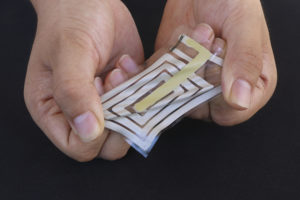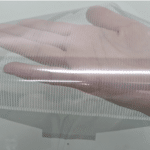Stanford engineers have developed a way to detect physiological signals emanating from the skin with sensors that stick like band-aids and beam wireless readings to a receiver clipped onto clothing.
Their goal was to create a technology that is comfortable and easy to use with no batteries or rigid circuits. The design was eventually successful with variations of the RFID technology. The similar technology used in an ID card, when the person holds up the ID card to a RFID receiver, an antenna in the ID card returns RFID energy from the receiver and uses to produce a code and guides it back to the receiver. The BodyNet sticker works in a similar manner to that of an ID card. It also has an antenna that yields the inward RFID energy from the receiver on the clothing to the power its sensors. The readings are then transferred from the skin and send them back to the receiver.
Using metallic ink, researchers screen-print an antenna and sensor onto a stretchable sticker designed to adhere to skin and track pulse and other health indicators, and beam these readings to a receiver on a person’s clothing.
Read more at: Stanford web site











